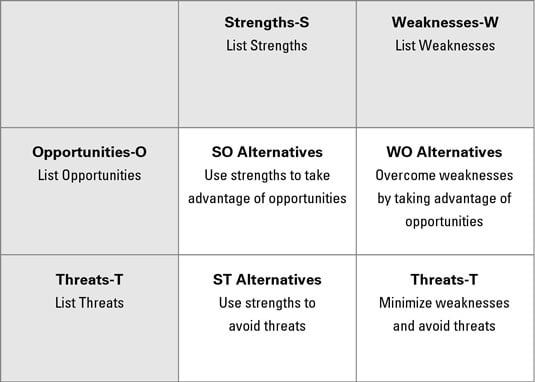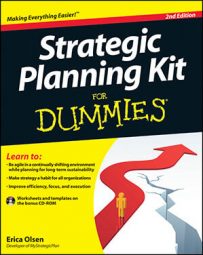After you’ve developed an analysis of your strengths, weaknesses, opportunities, and threats (SWOT), you can identify the alternatives or choices to build your strategic plan around. Remember that by itself, a SWOT isn’t actionable. But by matching up factors from one quadrant with factors in another quadrant, you can start to identify potential actions based on the SWOT anaylsis.
The point of matching internal factors with external ones is to identify a fit between organizational strengths and market opportunities. In other words, what opportunities can you take advantage of, based on what you’ve already got to work with? Also, by matching weaknesses with opportunities or threats, you may see some compelling pairs that are worth pursuing.
Get creative in this exercise! Put down all your ideas, even if they seem ridiculous. Allow yourself and your team to brainstorm. You can pull it back down to earth at the end of the exercise.

To develop a variety of choices, work through these steps with yourself or your team. Use the figure as a reference for the following steps:
Pull out your SWOT analysis (if you’ve completed that already).
No SWOT? Then pull one together for this exercise.
On a white board or a big piece of paper, draw a matrix similar to the figure.
If you have a lot of strengths, weaknesses, opportunities, or threats, you don’t have to rewrite them all in the matrix boxes, just work from a handout.
In the box labeled SO Alternatives, match internal strengths with external opportunities.
In the box labeled WO Alternatives, match internal weaknesses with external opportunities.
In the box labeled ST Alternatives, match internal strengths with external threats.
In the box labeled WT Alternatives, match internal weaknesses with external threats.
Review all four quadrants and highlight the choices that look the most promising.
Use the items you highlighted as a source of potential actions when developing your priorities.
Here are some generic examples of how this exercise works:
Strong reputation (strength) + market growth in a neighboring community (opportunity) = expanded operations in new market
High cost structure in a specific product line (weakness) + arrival of new technology that would reduce supply chain overhead (opportunity) = improved operations through technology investment
Cost advantages through proprietary knowledge (strength) + primary industry is in decline (threat) = entering new industry that leverages cost advantages
Poor employee morale (weakness) + tight labor market (threat) = development of an improved employee benefits package

